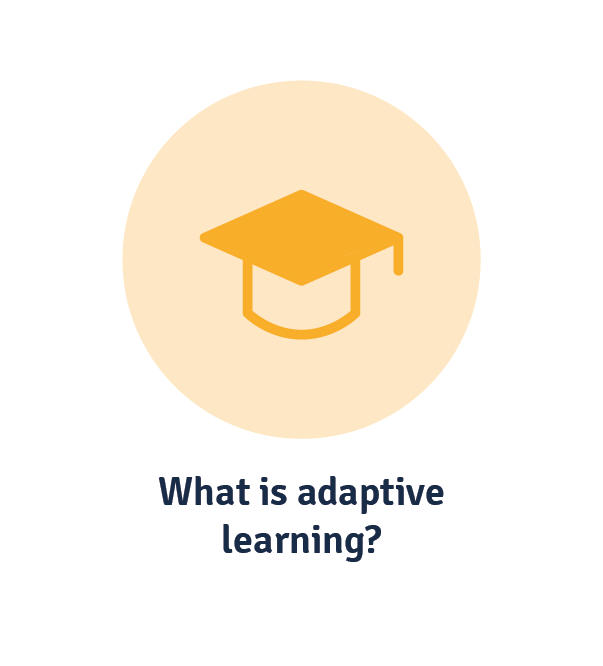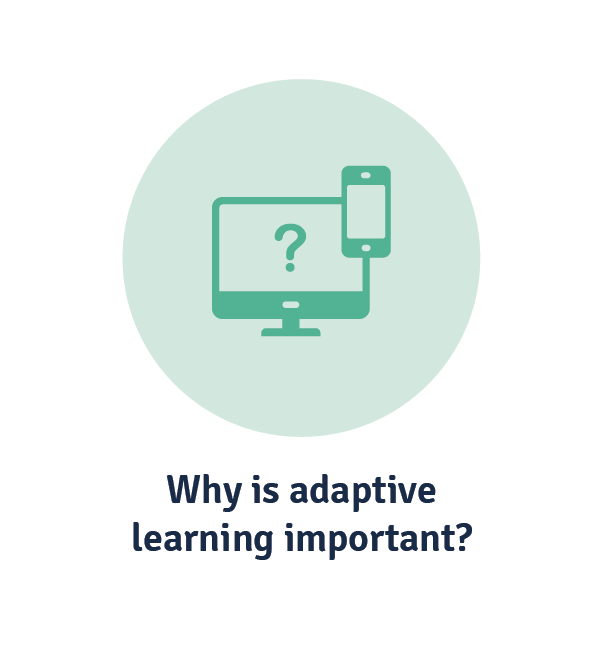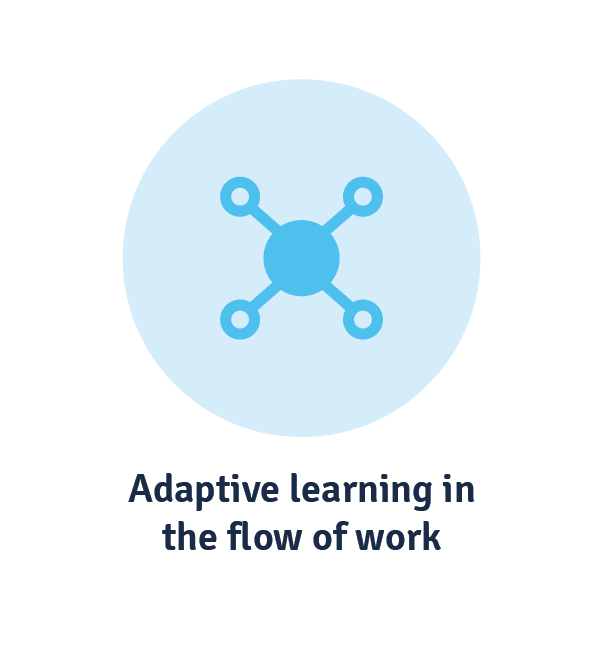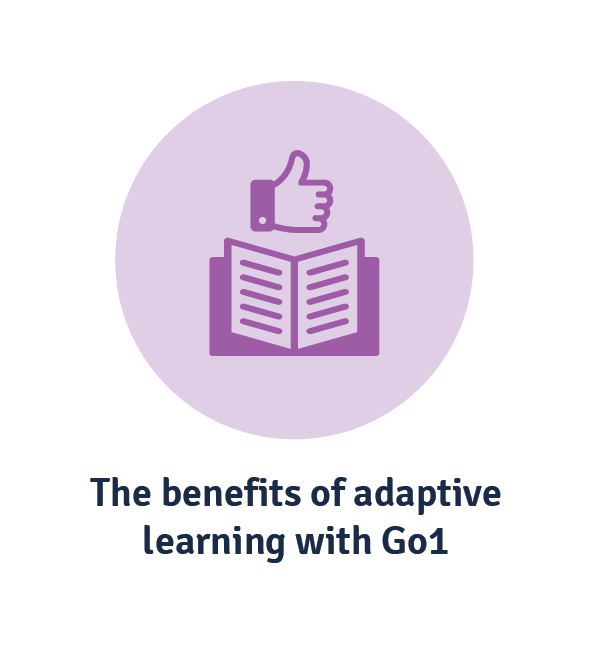Learning in the flow of work isn’t a new idea, but it’s one that often needs a little help from technology to find its feet. Enter: Adaptive learning.
Adaptive learning leverages artifical intelligence within eLearning platforms to adjust to an individual’s needs, exactly when it’s needed. Basically, the system autonomously optimises a learner’s chances of success—making it something that you’ll want to incorporate in your employee training.
Those chances of success are distinctly boosted with a rich library of learning content. Enter: Go1 Content Hub, where all your digital content dreams come true.
In this article, we’ll explore what adaptive learning is, why it’s so important, how to utilise in the flow of work and the many benefits of a Go1–LMS integration.
What is adaptive learning?
Tailoring course materials to the unique needs of an individual is a process known as adaptive learning. Technology-based adaptive learning through learning management systems provides learners with real-time feedback and relevant and timely resources that the software calculates a learner needing.
Why is adaptive learning important?
You need to train your employees—for any number of reasons like supporting growth and/or expansion—to change your wheelhouse or bridge capability gaps. Yet on two fronts, there are several ways that employee training can be impeded.
- For employees, generalised teaching approaches, broad content, rigid schedules, and poor access can all put a dampener on enthusiasm for training—even with a robust learning platform.
- On the other hand, data moves fast, both in your organisation and its learning and development (L&D) efforts. Manually analysing that data, monitoring individual learner progress and making interventions where needed is a great way to waste your time and smart learning technology.
You want adaptive learning in your workplace because it’s digitally led and shapes a custom learning experience by:
- Identifying individual capability gaps
- Delivering relevant learning materials
- Gathering regular feedback
- Adjusting pathways to accommodate learning pace, preference, and capabilities.
Using a combination of automation, artificial intelligence (AI) and curated content, adaptive learning systems makes for a more much seamless learning experience.
Adaptive learning vs personalised learning
It can be easy to confuse these two terms, considering ‘adaptive’ and ‘personalised’ may first appear interchangeable. However, there’s a marked difference, mainly in that adaptive learning supports personalised learning.
Personalised learning is a term to describe how instructors or facilitators can customise learning to suit differing abilities. Adaptive learning refers to how technology monitors a learner’s progress and uses that data to adjust learning pathways to cater to what learners already know, what they need to know and how best to learn it.
Essentially, when we’re talking about adaptive learning, we’re discussing the technology and materials (like a learning management system and learning content from an aggregator like Go1) that make for a more relevant and personalised learning experience.
We went a step further and pioneered the performance learning management system (PLMS) to a) provide curated learning experiences for individuals and b) ensure job mastery that delivers organisational excellence. It’s the only solution that guides learners to master the specific capabilities (skills, knowledge, behaviours, tools, and behaviours) of their job roles, with a right content at the right time approach to further facilitate learning in the flow of work.
Adaptive learning in the flow of work
Before we get into enabling it, let’s talk a little more about how adaptive learning can truly benefit employee training.
Like we’ve already said many times, one of the many hurdles to employee training is time. Employee training usually solves for long-term organisational needs, but not always day-to-day knowledge gaps. That could be anything from using certain software or understanding the target market to literally operational (and by default, safety) training. Employees don’t want to be trawling through pages of content for answers either (contrary to popular belief that consumers want more content and more time with it).
Enter: Adaptive learning. It’s a short-burst approach to learning that can support and be supported by this little L&D paradigm known as learning in the flow of work. The idea of using the flow of work to drive learning makes employee training ubiquitous, more personal and relevant to an employee’s day-to-day work, and helps mitigate the forgetting curve.

Why should we care about learning in the flow of work?
The most consequential and urgent applications of learning are rooted in content that helps employees not just perform better, but master their job role. It’s been proven that adults learn better when training is of immediate value.
Consider safety training. You could have an adaptive learning solution that can sends short videos (less than five minutes) to operators as they check in every morning. This content will have been carefully curated to deliver on a performance outcome that this operator needs to achieve, and only by correctly answering test questions can the operator be sure they are executing it.
In just one week, the operator has completed 25 minutes of adaptive learning—which is a minute more than the 24 minutes most people choose to give for traditional long form training. In short: adaptive learning can recommend relevant content and adjust recommendations as learners progress at their own pace.
The benefits of adaptive learning with a Go1–LMS integration
A key part of adaptive learning systems and personalised learning pathways is offering the right content, at the right time and in the right way for each individual learner. That’s not easy to manage manually. Enter the Go1–LMS integration.
The Go1 Content Hub providers around the world, effectively creating a giant extended digital library within your LMS’s (or PLMS’s) catalogue. (Belle from Beauty & the Beast would be very excited.) Combine that with a digital platform like Acorn PLMS, where all learning data is stored, and you’ve got an environment for meeting individual goals and achieving business objectives.
For business
If the aim is truly strategic learning and development, then adaptive learning needs to be part of your repertoire.
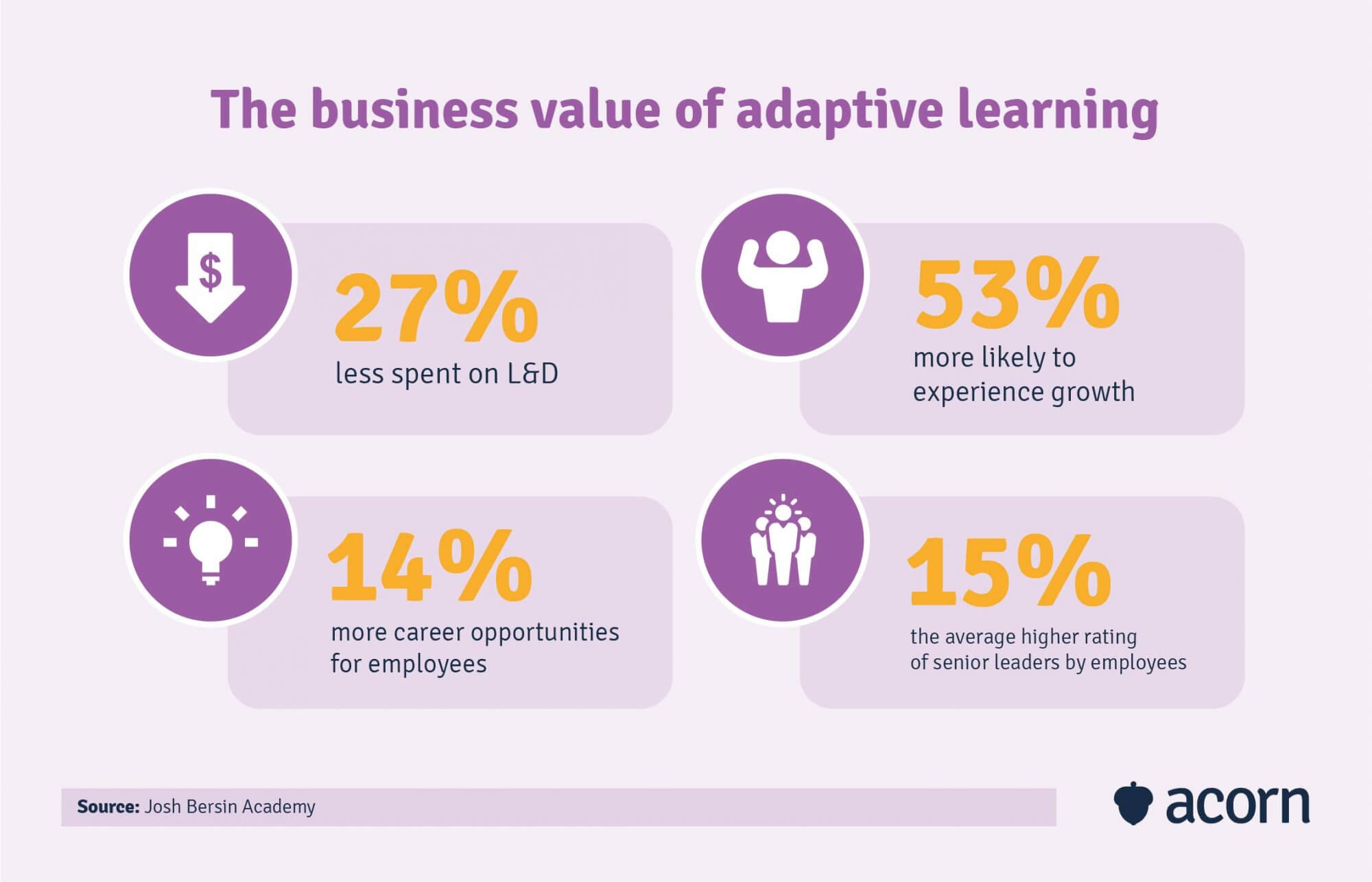
Address capability gaps
While many L&D efforts are measured by convenience (and adaptive learning does fit this brief), the more beneficial way to look at it is how effective learning has been. Adaptive learning is important on two fronts here.
- It helps deliver on workforce planning with regular feedback loops; and
- It reveals what learners need to focus on, which ultimately contributes to point 1.
As adaptive learning encourages learning in the flow of work, skills application becomes more self-regulated. The faster employees execute on new capabilities, the faster corresponding business benefits can be reaped. Even if employees fall behind the desired timeline, adaptive learning functionality gathers feedback on performance and reroutes learners accordingly. This can be reported on, too, thanks to the astute reporting functions of platforms like Acorn, to better inform talent and workforce planning activities.
And if you’ve taken great pains to map capability frameworks to learning content, you’ll only find your L&D strategy boosted by integrating your system with the Go1 Content Hub. The strength of content aggregation lies in the ability to host content not only from industry-leading content providers, but also consultants, thought leaders and professional associations. This enables your organisation to more effectively match demand needs with supply, particularly for large, diverse workforces.
Optimise resources
Employees spend less time away from work with adaptive learning frameworks. For, say, customer support staff, where time away from work is critical, it’s important to use your learning resources more shrewdly.
Thank the microlearning principle of adaptive learning; a series of short modules completed every week over one multi-day face-to-face course is a smarter way to use your employees’ time. There’s then no need to teach people what they already know, like may happen with an all-team encompassing approach.
It’s also a smarter use of your L&D budget. It’s costly to procure multiple third-party content providers, and not always feasible with current learning technology to create your own content in-house. One integration with Go1 puts a swathe of content in front of learners that has been curated just for them. This also minimises decision fatigue (aka a propensity for checking out when faced with too much choice), since this content is mapped to their personalised learning pathways.
Increased business value
Profitability, market share, revenue and innovation are all factors that are driven not only by the collective knowledge capital of your workforce, but how you train for it. Much like providing evergreen opportunities for development fosters a culture of lifelong learning, adaptive learning helps your company become an adaptive learning organisation.
The Josh Bersin Academy found that companies which utilise adaptive learning:
- Spend 27% less on learning and development
- Are 53% more likely to experience growth and deliver far greater business outcomes
- Sit far ahead of their peers with learning in the flow of work (sound familiar?)
- Can better predict and respond to market changes
- Provide a better employee experience, reduce turnover and create stronger employee productivity and customer loyalty
- Serve their own learning needs more efficiently and effectively.
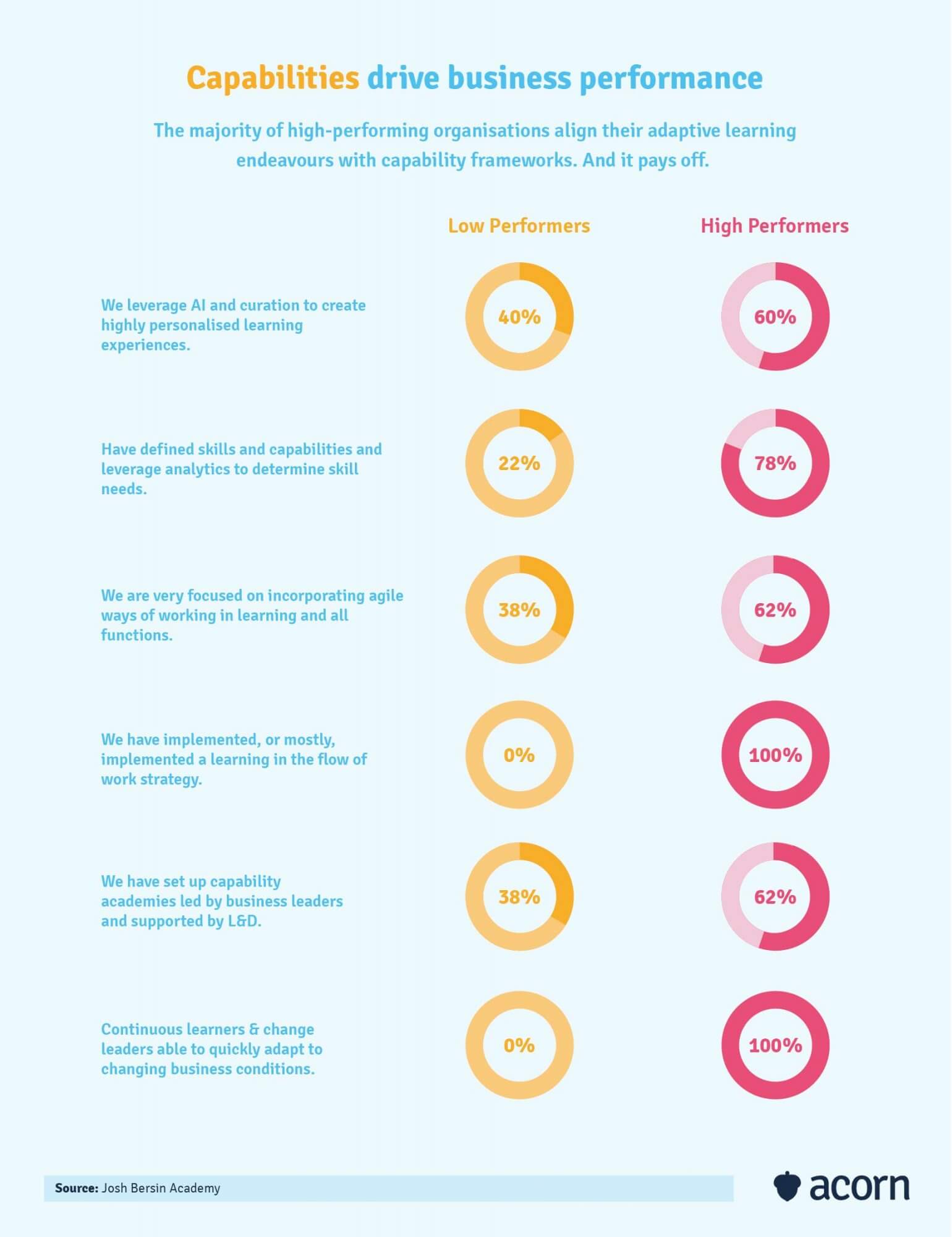
For employees
While it may seem hands-off and lacking a human touch, the use of machine learning ensures that all employees receive development opportunities tailored to their specific goals and needs.
Timely learning interventions
The first and foremost benefit of a Go1–LMS integration for employees is that their unique pain points can be equally addressed. There’s no vying for attention with other departments or even other team members with different learning needs, nor is there any time wasted searching for content.
The centralised, curated nature of Go1 content hosted within your PLMS means that any content learners choose to engage with has a heavy dose of context. It also means necessary company knowledge is stored in one place and can be easily reviewed, avoiding the trap of hidden or siloed workplace knowledge.
Also consider that sometimes people don’t know what they don’t know. If they’re on predetermined learning pathways, it can be hard for them to effectively gauge their own competencies. Manual monitoring often doesn’t provide the right interventions at the right time, which is where adaptive learning functionality can really offer a custom learning experience. That offers:
- Identified weak points and better self-evaluation of capabilities
- Timely interventions for knowledge gaps
- Appropriate level of challenge and complexity of knowledge
- Job role-specific information around products, services and processes.
Time effective
Most learners prefer a single learning platform, as it provides a familiar environment (and, as an aside, a simplified admin–vendor relationship). In another vein, thought leader Josh Bersin says adaptive learning is so important because technology is so embedded in most people’s lives—and we’re already so busy—that if learning doesn’t come to you in the flow of work, you may miss it entirely.
Adaptive learning runs with this by focusing attention on an individual to maximise their time in an PLMS. This could be switching content to better match their current cognizance, skipping content that they are already familiar with, or spending more time on a topic through different content styles (like videos and reading materials). When employees only have so much time to give to training each week, before in and outside of work, this is an incredibly effective way to ensure they’re still addressing capability gaps.
Confidence-based approach
Research has proven time and time again that learning technology helps learners feel more confident in their knowledge. Firstly, it takes the pressure of a classroom environment off more introverted or independent learners. Secondly (and perhaps more crucially), it ensures that without supervision, learners are still progressing at a rate that’s right for them and on a timeline that’s right for their organisations.
This is also where a Go1–PLMS integration is not just a want, but a need. For learners to be able to progress at an appropriate rate, the appropriate content must only be one passing grade away.
Imagine you’re a junior marketing coordinator on a pathway to a senior management position, as assigned by your manager who’s working within a capability framework. You’ve progressed through the current coursework way faster than anticipated, but the final program (say, a key leadership course) isn’t available right now because HR are still finalising a contract with a content provider that will have those courses.
Or, let’s say that the junior coordinator is struggling with some of the content, but the pathway is inflexible to their learning pace. Either way, not only is the employee’s progression stagnant (and their confidence deflated, and their everyday work impeded), but any workplace plans will experience a ripple effect.
As Go1 is always adding content from many third-party providers, automatically populating integrated LMS catalogues, there is always another course that can match a learner’s current proficiencies and comprehension.
Key takeaways
Adaptive learning is all about facilitating a seamless way of learning. As personalised learning becomes more and more important to retaining and training employees, your focus should be on how exactly you can do that at the least cost (but highest return) to your organisation.
Adaptive learning is important to support business objectives. Providing a unique training experience to every employee in an organisation is near-impossible without working 24/7. That’s why a little automation, and a lot of great digital content, is the best way to boost learning efficacy.
Adaptive learning is best achieved through a Go1–LMS integration. The combined power of Go1’s extensive content library within your LMS or PLMS offers the benefits of:
- Addressing capability gaps more efficiently
- Optimising your resources
- Increasing business value
- Providing timely learning interventions
- Maximising employees’ time
- Capitalising on a confidence-based approach.
As adaptive learning adapts to a learner’s pace and comprehension in real-time, it’s a great way to nurture learning in the flow of work. The short-burst nature of adaptive learning means you can provide development in the moments its most needed, making for a more impactful learning experience in your organisation.
Related Reads on This Topic

How Can a Go1 Integration Boost Your Workforce’s Digital Literacy?
Learn how to boost your workforce planning strategy by training for digital literacy with a Go1-LMS integration…

We Did a Deep Dive into Engaging Learners, and Here’s Why You Should Do It Too
The more you nurture employee development, the stronger your business becomes. Here’s how to strengthen the initiative and engage learners…

How to Develop a Learning and Development Strategy for Impactful Employee Training
An effective learning and development strategy fosters professional growth and upskilling. Find out how this can reshape your business today…
